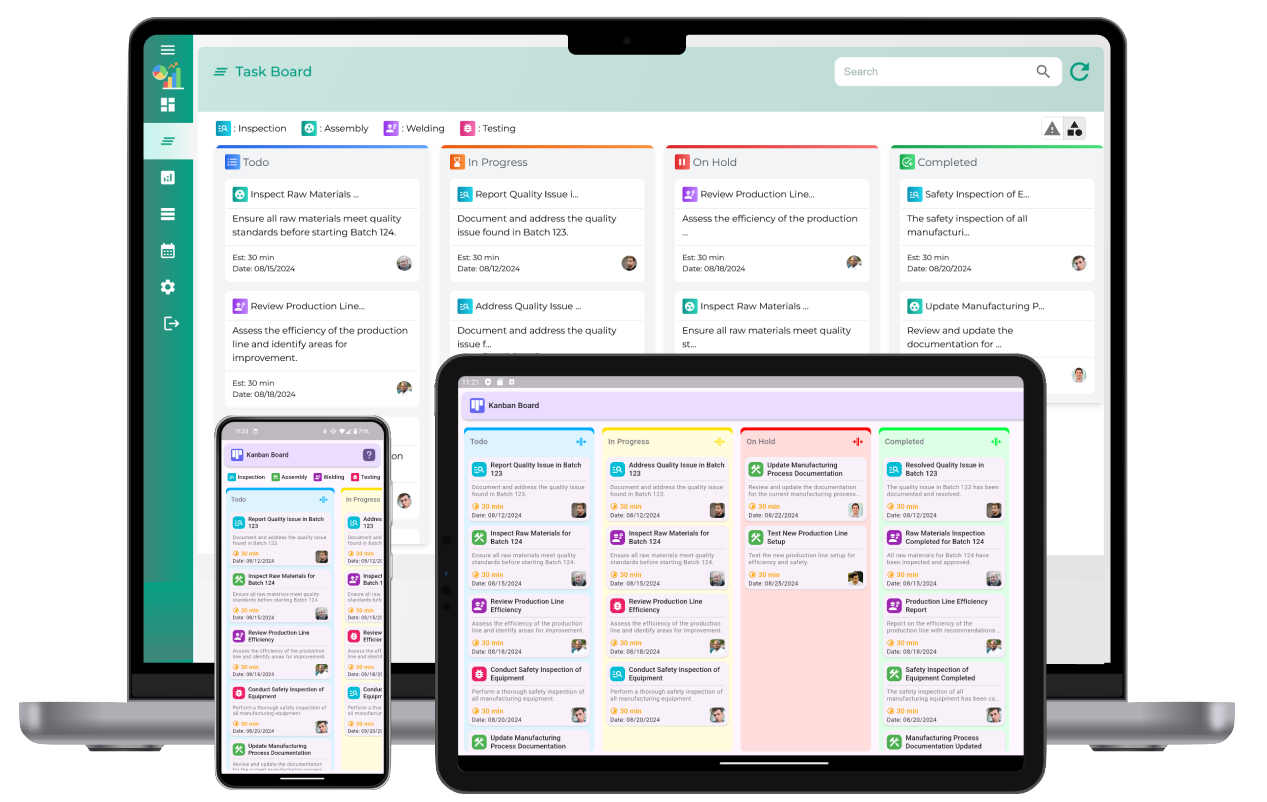In today’s fast-paced business environment, companies need efficient systems to manage workflows, track progress, and improve productivity. A Kanban board provides a visual representation of work processes, enabling teams to streamline operations, reduce waste, and enhance collaboration. Whether used in manufacturing, software development, or project management, a Kanban board helps businesses optimize resource allocation and ensure continuous improvement.

1. The Core Principles of Kanban
Kanban is a workflow management method based on visualizing work, limiting work-in-progress, and optimizing efficiency. The core principles include:
- Visualizing Workflow: A clear view of tasks and their current status.
- Limiting Work-in-Progress: Ensuring that work moves through the system at an optimal pace.
- Enhancing Flow: Reducing bottlenecks to improve overall productivity.
- Continuous Improvement: Encouraging teams to refine and improve processes over time.
2. Benefits of Using a Kanban Board
Implementing a Kanban board in your company offers several advantages:
- Improved Visibility: Teams can see the entire workflow at a glance, making it easier to track progress and identify bottlenecks.
- Better Task Management: Work is organized into stages such as "To Do," "In Progress," and "Completed."
- Increased Efficiency: Tasks flow smoothly through the process, reducing delays and inefficiencies.
- Enhanced Collaboration: Team members can coordinate efforts more effectively.
- Reduction of Waste: Identifying and eliminating non-essential activities improves resource utilization.
3. How to Set Up a Kanban Board for Your Business
Setting up a Kanban board involves defining workflows, organizing tasks, and ensuring continuous improvement. Follow these steps:
Step 1: Define Workflows
Identify the different stages in your process. Common stages include:
- Backlog: Tasks that are pending review or approval.
- To Do: Work items that need to be started.
- In Progress: Tasks actively being worked on.
- Review: Completed tasks pending approval.
- Done: Finished work ready for delivery.
Step 2: Create Task Cards
Each task should be represented by a card containing:
- Task name and description.
- Assigned team member(s).
- Priority level.
- Estimated completion time.
- Additional notes or attachments if necessary.
Step 3: Limit Work-in-Progress
Set limits on the number of tasks that can be in progress at the same time to prevent overloading team members.
Step 4: Monitor and Improve
Regularly review the Kanban board to identify inefficiencies, adjust workflows, and implement process improvements.
4. Overcoming Challenges in Kanban Implementation
While Kanban is an effective system, companies may face challenges such as:
- Resistance to Change: Employees may need training to adapt to a new workflow system.
- Lack of Consistency: Without regular updates, the board may become outdated.
- Work Overload: Failure to set clear work-in-progress limits can lead to inefficiencies.
To ensure successful implementation, companies should invest in training, encourage team collaboration, and regularly refine workflows based on performance data.
5. Future Trends in Kanban
As businesses continue to optimize workflows, Kanban boards are evolving with new features, including:
- Digital Integration: Cloud-based Kanban boards allow remote teams to collaborate in real-time.
- Automation: AI-powered analytics help optimize task assignments and identify bottlenecks.
- IoT-Connected Systems: In manufacturing, real-time data from machines can be integrated into Kanban workflows for better production management.
By adopting a Kanban board, businesses can enhance efficiency, reduce waste, and create a more agile and responsive
Why Does Your Company Need a Kanban board?
What is a Kanban board?
A Kanban board is a visual workflow management tool that helps teams track and manage tasks efficiently by organizing them into stages such as "To Do," "In Progress," and "Completed."
Why is a Kanban board important for workflow management?
It provides a clear, visual representation of tasks, ensuring that work progresses smoothly while minimizing bottlenecks.
How does a Kanban board improve team productivity?
By reducing multitasking, prioritizing tasks, and ensuring better workflow transparency, a Kanban board enhances team efficiency.
Can a Kanban board help in reducing task bottlenecks?
Yes, by identifying stalled tasks and balancing workload distribution, teams can resolve bottlenecks quickly.
How does a Kanban board enhance visual task management?
It provides a real-time visual representation of tasks and their progress, making it easier to track and manage workloads.
What are the key components of a Kanban board?
Essential components include task cards, workflow columns, work-in-progress limits, and task ownership.
How does a Kanban board support continuous improvement?
By regularly analyzing workflow efficiency, teams can make iterative improvements to optimize productivity.
Can a Kanban board integrate with other project management tools?
Yes, many Kanban systems can be linked with ERP, MES, or task management platforms for seamless workflow management.
How does a Kanban board help in workload balancing?
It ensures that tasks are evenly distributed among team members, preventing overload and maintaining efficiency.
Can a Kanban board be used for remote team collaboration?
Yes, digital Kanban boards enable real-time updates, ensuring that remote teams stay aligned and productive.
How does a Kanban board improve efficiency in manufacturing?
By tracking production tasks, identifying delays, and ensuring smooth workflow transitions, it enhances operational efficiency.
Is a Kanban board suitable for agile project management?
Yes, it supports agile workflows by enabling continuous task updates, adaptability, and iterative improvements.
What are the long-term benefits of using a Kanban board?
It fosters transparency, improves task prioritization, streamlines communication, and enhances overall workflow efficiency.
How does a Kanban board support lean management principles?
By minimizing waste, reducing inefficiencies, and optimizing work processes, it aligns with lean management strategies.
What should companies consider when setting up a Kanban board?
Businesses should define clear workflow stages, establish work-in-progress limits, and ensure regular reviews for process improvements.